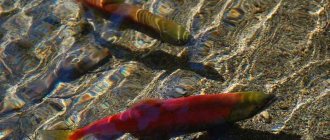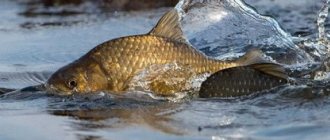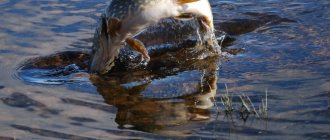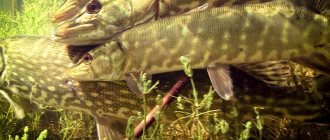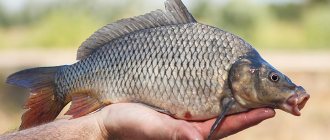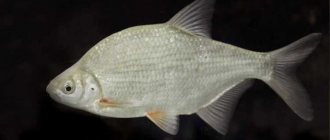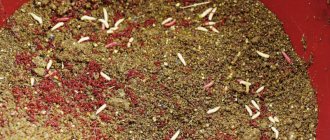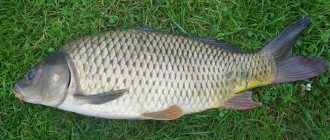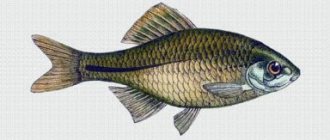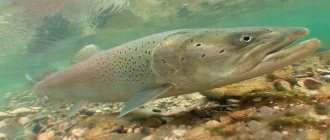Reproduction time
Carp spawning begins when the water temperature in the reservoir rises to 18-20 degrees. Of the folk signs, the beginning of this process is marked by two:
- first - wheat blooms;
- second - the boys begin to swim in the pond.
In the same area, carp spawning begins at different times, this depends on the characteristics of a particular pond or lake, its location, depth, the presence of flowing streams, and so on. In central Russia, carp spawning begins from late May to mid-June, just at this time the water temperature here is optimal for the reproduction of domesticated carp.
The duration of the spawning period is different in each year; the fact is that females spawn in batches, over 2-3 days. If a sharp cold snap occurs at this time, the spawning stops until the air temperature rises and good weather sets in. The entire process of spawning in each reservoir usually lasts no more than ten days.
When does spawning of carp (carp) end?
The average duration of spawning for carp and carp is 1.5-2 weeks, with each group spawning at different times: larger individuals spawn first, and smaller individuals last. In this case, the female can lay eggs in stages, returning to this process a few days later, which explains the presence of eggs in the caught fish even after the end of the spawning period. But the start and end time of spawning depends on many factors:
- Warming up the water to the desired temperature;
- The presence of rich aquatic vegetation;
- From the time of the river flood;
- From the region.
But even this is not an indicator.
After all, in the same area on rivers with a fast current, spawning will begin faster than on rivers with a slow one. The same can be said regarding lakes - on larger and deeper lakes, carp will swim to the spawning grounds later than on shallower ones. After the end of spawning, at least 2-3 weeks must pass before the carp comes to its senses and begins to feed. At the same time, we should not forget that during spawning there is a ban on fishing for carp and carp; its terms depend on the region where the fish live. It can last from late May to early July.
An interesting observation: the spawning site of carp can be determined by large schools of roach that come to feast on delicious caviar. This is delicious: Hungarian carp soup
Features of the spawning process
Domestic carp always spawn in the pond in the same place. This is shallow water overgrown with aquatic vegetation. The layer of water in such a place is often no higher than the height of the fish at the withers; it happens that a carp, having entered shallow water to spawn, cannot then leave it due to the decline in water and dies. And if the water dries out even more, then the offspring locked in some kind of whirlpool or bay may die.
On the river, spawning grounds can change from year to year due to the variability of the river bed. In this case, carp spawning begins with several scout families. They are, as it were, checking a place for spawning; if they are “approved,” the rest of the flock will come here too.
Spawning begins in the morning at dawn, and fish gather on spawning grounds in the evening throughout the night. The process itself can be divided into several stages:
- The female and several males rub their sides, causing the release of eggs and milk.
- Mom sweeps out a portion trail of caviar.
- After the female, the future fathers swim from above the clutch and cover the eggs with a milky blanket, often jumping out of the water. The milk is shot out with strong pressure, so that the area it covers the eggs is quite large, which has a positive effect on the quality of fertilization.
- After spawning, moms and dads go in different directions and are no longer interested in each other or their offspring.
Of almost 300 thousand eggs, only three thousand fry usually hatch; the rest of the eggs are eaten by birds and aquatic inhabitants or dry out when the water level drops. In general, only three hundred carp will live to reach the age of one year; here predators, pike and perch, will work.
The carelessness of the normally cautious carp during spawning is simply amazing. The fish forgets about everything when it gives in to the call of the flesh.
Story from the author:
There was a case when a friend and I were sitting on a pond, catching crucian carp at dawn. The time coincided with the spawning of carp. On the opposite shore, in the shallows in the grass, water was boiling from the fish’s “love.”
From the same side, a man from the nearest village appeared, walking towards the regional center. I saw the spawning process and turned back. He returned with a huge club, took aim, and how it hit the water! A couple of minutes later he was already pulling a stunned carp weighing five kilos out of the water. Carefully placing the club in the grass, he put the carp in the prepared bag, threw it behind his back and dragged it home. We just opened our mouths!
Spawning process
The quality of carp spawning is influenced not only by climatic conditions, but also by its age. Having reached the age of three, the carp is completely ready to give birth. By this age, the male reaches 25-29 cm in length, and the female from 30 to 35 cm.
During spawning, the female can jump out of the water
Active spawning occurs before dawn and gradually fades towards noon. During the day and at night, carp continue to spawn, but the process is extremely sluggish. The spawning process is quite interesting. One female, ready to spawn, is courted by 2 or 3 males. They push each other aside and chase the female around a limited space in which eggs will be laid. The female jumps out of the water from time to time and hits it. By doing this, she breaks the bag of caviar and prepares it for release.
When the eggs begin to appear, the males expel their milk. The first time, the female produces about half of the eggs, after which she goes off for a short rest. After resting, she releases all the eggs in one or two times. While the males are resting, the females begin to rub against the plants. By such actions they facilitate the release of milk for insemination of eggs. The process of milk release is accompanied by a strong noise and a characteristic whistle. The insemination process is so active that it can be seen from afar on the surface of the water.
Read How to Use Molasses for Fishing
Despite the large amount of eggs released during spawning, only a small part of the offspring survives
Carp spawning lasts about a month, starting in mid-May. During the spawning season, a certain age continuity is observed. The young ones spawn first. It is the most active and its spawning occurs quickly. The period of laying eggs is completed by large fish. The spawning period of each age group lasts from 8 to 11 days. This allows different groups to use the same spawning sites several times. Fertilized eggs mature in 3-5 days, after which the larvae appear.
A characteristic difference is that the female often does not completely throw out all the eggs. Back in August, you can catch a female with eggs inside. This may be due to changes in weather and colder water. In this case, the female stops spawning. When the previous conditions are restored, she can begin the spawning procedure again. When the spawning is completed, all its participants return to their usual habitat.
At the end of spawning, the carp retires and its activity decreases sharply
The influence of spawn on the bite
As for the peculiarities of biting during the period before spawning, during spawning and after it, carp behaves the same as most other species of fish. Conventionally, periods of activity of domestic carp are divided into the following periods:
- Early spring. When the fish begins to wake up after hibernation and begins to feed heavily, it prefers high-calorie animal food. The best baits are a bunch of worms or bloodworms; boilies with meat or fish flavors are also used. The bite has begun.
- Before spawning. Carps eat intensely, and prefer small-fraction food due to swollen caviar and milt. The bite reaches a peak, but not a maximum. Carp are caught at this time using the smallest boilies, worms, and maggots.
- Spawning. Only immature individuals under three years of age feed. At this time, carp from three hundred grams to half a kilogram are biting well. These undergrowth will eat everything that is offered to them: from bloodworms to corn.
- After the spawn. The weakened fish begins to eat little by little, restoring its strength. Gradually, the carp's appetites increase, and after a week a real glutton sets in, lasting 7-12 days. Preference in nutrition is changing to plant components. The animal flavor changes first to spicy and then to sweet fruity flavors.
- Summer. After the meal, the fish’s activity stabilizes, and it bites in a natural, measured rhythm.
If at the beginning of spring it is difficult to find a certain point of carp parking, due to the scarcity of the early spring diet, the fish are in constant search for food, then before spawning, carps occupy places on the border with future spawning grounds.
Having spawned, they roll down to almost the same points, gradually moving into the pools and to the edges. Therefore, after spawning, it is advisable to first examine the nearest changes in depth near carp spawning grounds: coastal holes and steps. And of course, carp can always be found near some snag where the fish feels most protected.
lovlyavsem.ru
When does carp spawn in the middle zone?
Carp spawning is a little different from many other fish. The fact is that in the middle zone, carp spawning can actively begin as early as the 20th of April. Closer to May, this phenomenon becomes more common, and the peak occurs at the beginning of June.
In general, the spawning of some individuals can continue until mid-August, although these are rather exceptional cases that should not be taken into account.
How long does it take for carp to spawn?
Typically, carp spawning lasts one month. True, this phenomenon is not chaotic and can often drag on for a longer period. The fact is that this fish has a clear hierarchy. The youngest fish spawn first, and then it’s time for older and larger individuals.
If we talk about a specific time of day, then everything starts before dawn and ends closer to noon.
At what temperature do carp spawn?
As mentioned earlier, fish activity depends on air temperature. Usually, when the flood begins in the spring, the fish begin to behave more actively, but this is still not the peak.
Let's try to figure out the main features of this issue:
- Favorable temperature is 18 – 21 degrees.
- In cold water, fish do not lay eggs.
- If at the end of spring or early summer the weather is very hot and the water warms up greatly, the activity of the fish drops significantly and there is no need to wait for it.
Based on the above information, we can conclude that river fish begins to increase their activity earlier. This happens because the water in ponds warms up faster than in rivers.
Spawning period of carp
Let's consider a list of the main features by which a fisherman, and even an ordinary person, can determine a given period.
- Males often swim near females, periodically creating splashes of water to attract them. This can be heard perfectly when there is no extraneous noise. Fishermen often walk around a body of water, listening for the most splashes to determine the best spot.
- During this period, the scales of males become covered with small tubercles, which can be seen with your own eyes. Therefore, if you see something like this, you shouldn’t be scared; in this way, males simplify the release of germ cells.
- Females, while laying eggs, spread them with their tail. Moreover, this does not happen chaotically or accidentally. The female makes sure that the spark gets into hard-to-reach places or sticks to underwater vegetation.
- Immediately behind such a female comes the male, who covers the entire eggs with a strong stream of milk.
Features of carp spawning
With the advent of the first rays of the sun, while it is not yet very hot, the fish begin to show strong activity. The females begin to rush around the pond, looking for a suitable place, and after them several males swim at once, who are already ready to fertilize the eggs.
Similar games continue until the water warms up greatly. In such water you should not expect any activity from the carp; it will simply swim quietly and peacefully.
How long does carp stay sick after spawning?
Usually this period takes several weeks, and the fish is completely restored closer to the beginning of July. But it’s worth saying right away that due to different delay times for individuals, some fish are always active.
Can carp be caught during spawning?
We can say with some confidence that it is possible to catch fish, but it just becomes a little more difficult. If we talk specifically about the peak of activity, then the bite in males decreases by an average of 30-40%, and in females, in turn, it can decrease to 70-80%.
But don’t despair, activity will increase every day after spawning.
Features of spawning in a pond
The grating process in the pond is indeed slightly different for this species. Ponds, unlike rivers, usually do not overflow as much, which means it is possible to lay offspring closer to the shore.
Usually, spouses choose hard-to-reach places in shallow water. This could be dense thickets of grass or tree roots. Unlike their river counterparts, spawning in ponds can begin earlier, as early as 15 degrees. However, the peak will also be around 18-20 degrees.
Carp spawning in Belarus
Carp spawning in Belarus is not very different from other CIS countries. The only peculiarity is a strict ban on fishing during spawning. While in other countries people often turn a blind eye to this, here it’s the other way around.
Typically, time periods are established during which fishing is prohibited. If we talk specifically about carp, then this is almost always the period from May 31 to July 1.
Carp spawning in the Urals
There are indeed a number of quite serious differences here. One of the main ones is the temperature at which individuals begin mating. Their main peak occurs at 16-18 degrees.
Where does carp spawn?
Carp and carp that live in rivers spawn when they are in flood. If the spill was strong and covered a large coastal area, then carp eggs are most often left to dry on the grass after the water recedes, or are pecked by birds. If the spill was not of a serious scale, then the carp prefers creeks with holes and small reaches for its clutches. Read also: Fines for fishing during spawning
Pond carp choose places with dense vegetation and clean water for spawning. It is better if there is a stream or canal flowing into the reservoir nearby. Carp come out in large groups into shallow water into reeds or thickets of water lilies. This is delicious: Stewed carp with mushrooms
The behavior of carp and carp during the spawning period is very peculiar:
- females fly to the surface of the water and loudly splash their tails, spraying eggs over a maximum distance;
- after the male squeezes out his milk, the females begin to whistle specifically;
- the entire spawning process takes several hours - it begins at dawn and ends by noon;
- males swim among females and attract their attention with noisy sounds - squelching, splashing, etc.;
- During spawning, small pimples appear on the scales of males, which should not be feared, since they are not signs of any disease.
This is not to say that during spawning carp stops biting altogether. Yes, his activity decreases significantly, more than twice, but he continues to feed and sometimes gets hooked. However, despite the temporary lack of bite, there is no need to worry too much - in a couple of weeks, when the fish recovers, it will begin to really eat. Read also: Catching carp with corn
When do carp bite after spawning?
Most often, biting begins 15-20 days after the main phase of egg laying. However, it is difficult to say exact numbers due to the fact that the process itself can last more than a month for the entire species.
It is worth considering other features. For example, in colder regions the bite may begin earlier, within a week.
In general, it is extremely difficult to determine the exact time, but it is still possible to approximately calculate it. The main spawning activity occurs in late May and early June. It’s better not to fish at this time, and in mid-June. A good bite begins closer to the mid-twenties of June and returns to normal closer to early-mid July.
Rest after spawning
Such rest manifests itself as a strong decrease in the activity of individuals. They become a little childish and don't want to do anything, not even take the bait. Master fishermen still manage to catch them during such periods, but it is difficult to do.
bolshoyulov.ru
What does carp spawning depend on?
Carps are very hardy fish; in order to reach the place where eggs are laid, they overcome a difficult path. On their way there are dams and low dams, but this is not a hindrance for them. The ability to jump out of the water up to two meters helps them achieve their goal.
Spawning grounds are chosen in places:
- overgrown with reeds and water lilies;
- bottom driftwood.
This happens so that you can protect your “descendants”, that is, hide them. For them, such fates are considered successful.
There are approximately five to six individuals in one group. An interesting fact is that females themselves choose several partners and... The female is slightly larger and thicker than the males.
What time of year does carp spawn?
The spawning time of carp begins in the spring , when the sun has already sufficiently warmed the water, that is, at the end of May . But the revival of fish after the winter period begins in April: it rises from a deep wintering hole and gradually begins to live off the coast, on the surface of the water. The revival of fish begins in late spring at temperatures above 25 degrees, then the spawning process occurs in early June. The water must warm up sufficiently, otherwise in a cold reservoir the reproduction of carp fry becomes much more difficult. If the water temperature drops sharply, the offspring may even die.
The beginning of carp spawning also depends on the characteristics of the river where the carp lives.
For example, carp are too squeamish to live in stagnant water, but lake carp can easily be found in thickets, flooded lakes with stagnant water. All they need is a place to attach their eggs.
The average duration of spawning is a month (depending on temperature). If you believe folk superstitions, the process begins when the wheat blooms (when the weather has lasted at an optimally warm temperature for several weeks).
The spawning process itself takes about a month for carp. In addition, everything happens not chaotically, but naturally according to the hierarchy of age. The youngest fish spawn first, then the older and larger ones. In poor water conditions, they can slow down the spawning process until favorable conditions occur.
Spawning begins before sunrise and ends by midday.
When does spawning of carp (carp) begin?
Carp spawning begins immediately after several important conditions are met:
- the water temperature should rise to at least +18 degrees Celsius;
- The age of the fish should not be less than two years.
Here are a few signs that can be used to roughly guide you towards the beginning of spawning time:
- young growths of reeds and cattails completely replaced last year's dried thickets from the water;
- the lilac blossomed;
- the acacia blossomed;
- the beginning of wheat flowering;
- a couple of weeks before spawning, you can see a couple of carp in shallow water; they, like scouts, are studying the upcoming spawning site.
It is clear that these signs are indirect in nature, since the weather and natural conditions differ strikingly from each other depending on the location of the reservoir - north, south, middle zone, Far East, etc. Good to know: Fishing weather
Naturally, in different regions these signs and symptoms do not occur simultaneously, which means that in southern latitudes, carp spawning begins in mid-to-late May, in middle latitudes - at the end of May-beginning of June, in northern latitudes - no earlier than mid-to-late May summer month. But, be that as it may, in most regions of our country, carp and carp spawn at the usual time - late May-early June. Interesting: Spawning period in the Rostov region
Spawning conditions
Let's figure out in which parts of the reservoirs carp spawn and at what age?
The peculiarity of spawning in river carp is that they scout the territory to see how suitable it is for the breeding process. In a day or two, several carp swim to the intended place, and the next day all the “newlyweds” appear. And carp mostly spawn in the same places every year. In order to get a place, the fish need to make every effort. Carps overcome all possible obstacles on the way, jump over ponds and high dams, and jump out of the water. Basically, carp choose places for spawning away from the dam - there are the most comfortable and shallow places.
Another feature is that the fish will go to a higher level of the reservoir if the water level is high enough. And vice versa - if the carp constantly lives in shallow water, then there is a high probability of it spawning in the same place.
At what temperature does carp spawn?
For carp, water temperature during spawning is very important. At temperatures up to 20 degrees, the fry hatch after 10-13 days, but if the temperature does not reach 15 degrees, then the process is delayed for 3-4 weeks. A sharp cold snap leads to the death of embryos.
How to increase your fish catch? ">
Over 7 years of active fishing, I have found dozens of ways to improve the bite. Here are the most effective ones:
- Bite activator . This pheromone additive attracts fish most strongly in cold and warm water. Discussion of the bite activator “Hungry Fish”.
- Increased gear sensitivity. Read the appropriate manuals for your specific type of gear.
- Pheromone -based lures .
Places where carp spawn
When the time approaches for carp to spawn in a pond, it begins to actively swim around the reservoir, scouting the territory and choosing the most suitable site for breeding. While the fish is choosing places, it swims alone long before spawning, and when the spawn approaches, both the male and the female swim at once. Carp tend to breed annually in their favorite places, and carp choose a place each time, although it often coincides with the previous year.
Read more
How and what to catch catfish in the fall?
Basically, the signal for the start of spawning is the established warm weather, both during the day and at night.
To breed carp in a pond, you should understand that it prefers hard-to-reach places. The fish overcomes serious obstacles and makes great efforts. Carps are often observed jumping over ponds and dams, even relatively high ones. Cyprinids like to choose places where there is no great depth and away from the dam.
Carp prefer to rise to high water levels if they swim in deeper water more often. If an individual prefers shallow water, most likely spawning occurs in such a place.
When the river floods heavily, carp tends to move away from the riverbed, looking closely at places with shallow depth and minimal current. Because of this feature of the fish, carp eggs often become a delicacy for birds or a drop in water level leads to the drying out of the eggs. If the river flood is small, carp prefer bays, holes and reaches.
The behavior of carp before spawning is associated with strangeness in certain reservoirs - first a couple of adult fish arrive, and after a thorough study of the place, they bring a whole flock to the spawning site. This behavior is more often observed in river carp following flooded meadows. This behavior is a good sign of massive spawning. Females lead the group.
When does carp bite better: before spawning or after?
The active carp fishing season begins a week or two after the end of spawning. The most successful fishing occurs in the summer, when the water temperature is 20 degrees. With the onset of cold weather or the slightest drop in water temperature, the catch drops sharply. And in mid-September - early October it stops altogether until the onset of spring.
After hibernation, carp always begin to spawn. The carp bites after spawning , actively restoring its strength. Accordingly, the fish actively feed when the water warms up to 20 degrees .
In addition to the onset of the season, there are other influencing factors on fishing: weather, size and depth of the river or lake. For example, a reservoir up to 2 m deep will warm up in 4-5 days at an air temperature of 20 degrees. Therefore, you can start carp fishing under such conditions. But in deep reservoirs you should not fish at depth; it is better to stay in shallow water (1.5-2 m). In such places, the water warms up faster and absorbs more oxygen.
Using binoculars, you can observe the river or lake where carp live and feed. Especially before starting active fishing for it.
If a carp lives in a reservoir with stagnant water, after winter it will be sorely lacking in oxygen. At such a time and place, fishing will have the lowest results.
It is better to feed carp with crawlers and large worms. For carp, you should choose vegetable bait. The time for more successful carp fishing is during the day, the weather and temperature are stable. If you decide to catch carp before spawning, choose places near the mouth of the stream. There is the largest concentration of fish there.
Below is a video about catching carp on a feeder after spawning:
When breeding carp in your own ponds, the main focus is on preserving young fish (they rarely live to large sizes).
Spawning is a very important life period for any fish. For carp, the spawning period is : late May - mid-June. A peculiarity of carp is cases of infertility of fish. Yal fish will be tastier and fattier and more fertile. It is not too difficult to distinguish these species: barnacles have thick lips, a significantly shortened body, and a small belly.
hariuz.ru
Laying eggs
The fisherman must know how and when spawning begins for each species. This will not only affect the percentage of successful catches, but will also help him avoid fines. After all, as you know, fishing is prohibited during this period.
Usually fish spawning occurs after a long feeding period. This is the golden time for the fisherman, when the prey begins to actively bite, and equally well on various baits and baits. For many species, food of animal origin is especially popular during the pre-spawning period, allowing them to obtain much larger amounts of substances useful for life and future reproduction.
Read DIY boat motor
This period before spawning, unfortunately for fishermen, does not last long: from seven to fourteen days. At the same time, predators fatten a little longer than other types of fish. For example, in cyprinids, spawning occurs so quickly that you can simply not notice it.
Catching carp (carp) before spawning
Such early spring fishing requires knowledge of the reservoir and the places where the fish go when the ice melts. In cold water before spawning, the carp practically does not feed, maintaining a sleepy winter mood. For fishermen in an unfamiliar body of water, the task becomes more difficult, since before starting fishing it is necessary to be patient and, through numerous casts, determine the average depths at the exit from the wintering holes.
The essence of spring fishing for carp before spawning is that the bait must be cast, which is called “under the nose.” In addition to accurate casting, experienced fishermen use several more tricks:
- The fish are fed in a PVA net.
- Choose a medium-sized boilie.
- The hook is disguised with a worm.
- They focus the fish on alcohol bait, which spreads quickly in the cold waters of the reservoir and has a too pungent, but not sweet, smell.
The gear is thrown sequentially along the steepest slope to the expected depth. Each subsequent rig should go a little deeper than the previous one.
Just before spawning, carp experience a short period of hunger. Knowing the reservoir well and understanding the behavior of fish in it, this period can be determined by observing weather changes and the gradual warming of the water.
Before the ban began, but at a time when the water had already begun to warm up, fishermen switched to “tasty” baits and lures. Of course, their choice depends on the reservoir where the fish lives and what kind of food is familiar to it.
For fishing, feeders are actively used, which are lowered to a sufficient depth. The bait is applied pointwise, and rolled oats, corn flour, chopped worms, maggots or bloodworms are added to the mixture.
The behavior of carp before spawning is unpredictable, and many novice fishermen, seeing that the fish are splashing under the shore, cast the tackle shallowly. This common mistake practically reduces the chances of a bite to zero. In the spring, before spawning, carp never bite in shallow water, so hoping for a trophy must be patiently casting the equipment into a well-fed place.
Spawning of carp and carp
Carp and carp choose shallow water areas for spawning, and small fish are sent there after wintering. For them, this time often coincides with the maximum flood of water in the spring in the reservoir, but large specimens spawn a little later - when the water begins to decrease.
In rivers, places for spawning are shallow floods with a weak current, and in lakes and ponds there are quiet backwaters, overgrown with abundant vegetation, with a depth of 0.5 to 1 m. Sometimes they become a kind of trap - swimming into a temporary flood in which the water is already decreasing , the carp dooms its offspring to death, since when the water level drops, access to the main body of water may be blocked, and a small spill subsequently dries up completely.
The difference between the spawning of carp and carp is that the carp annually scouts for the best place for spawning, but the carp prefers to spawn annually in the same favorite places.
Attention! For the normal functioning of carp and carp, they urgently need an appropriate level of oxygen in the water, so neither carp nor carp will spawn in swampy reservoirs with a low oxygen content. At the same time, carp is much more demanding of the presence of oxygen in water than its domesticated relative carp. The spawning process lasts about 12 days, however, taking into account the difference in the age of fish, the entire spawning period lasts about a month
Moreover, the warmer the water, the faster the spawning process takes place, which is carried out in several stages
The spawning process lasts about 12 days, but taking into account the difference in the age of the fish, the entire spawning period lasts about a month. Moreover, the warmer the water, the faster the spawning process takes place, which is carried out in several stages.
Spawning itself occurs as follows: at sunrise, the female, accompanied by several males, begins to spawn, periodically jumping out of the water, while the males, with a characteristic whistle, which is accompanied by a powerful expulsion of milk, fertilize the spawned eggs. The milk spreads over several meters in the water, capturing a huge number of eggs. Spawning time ends around noon.
Interesting! Carp is much more prolific than carp. During the spawning period, a female carp spawns up to two million eggs.
When the water temperature is about 20 degrees, the eggs hatch into fry within 10-14 days, but if it gets colder, the process can take up to three weeks. There are cases when eggs die due to significant cold temperatures. The fry first feeds on plankton, and over time moves on to larger food. The size of fingerlings can reach up to 10 cm.
Read: Cicada spinning bait (bladebait)